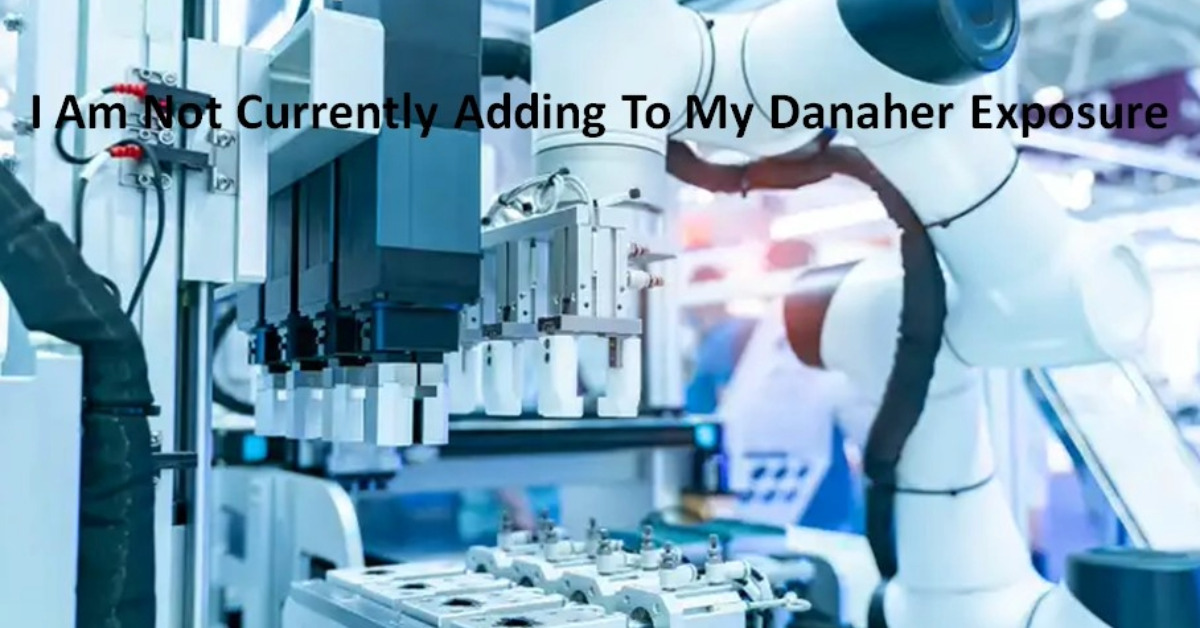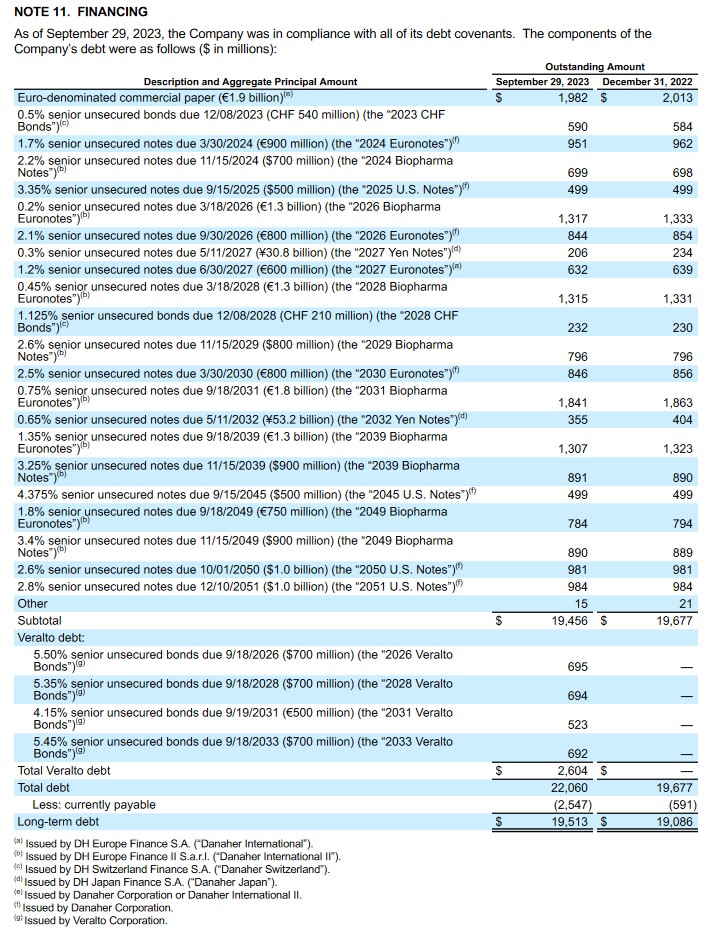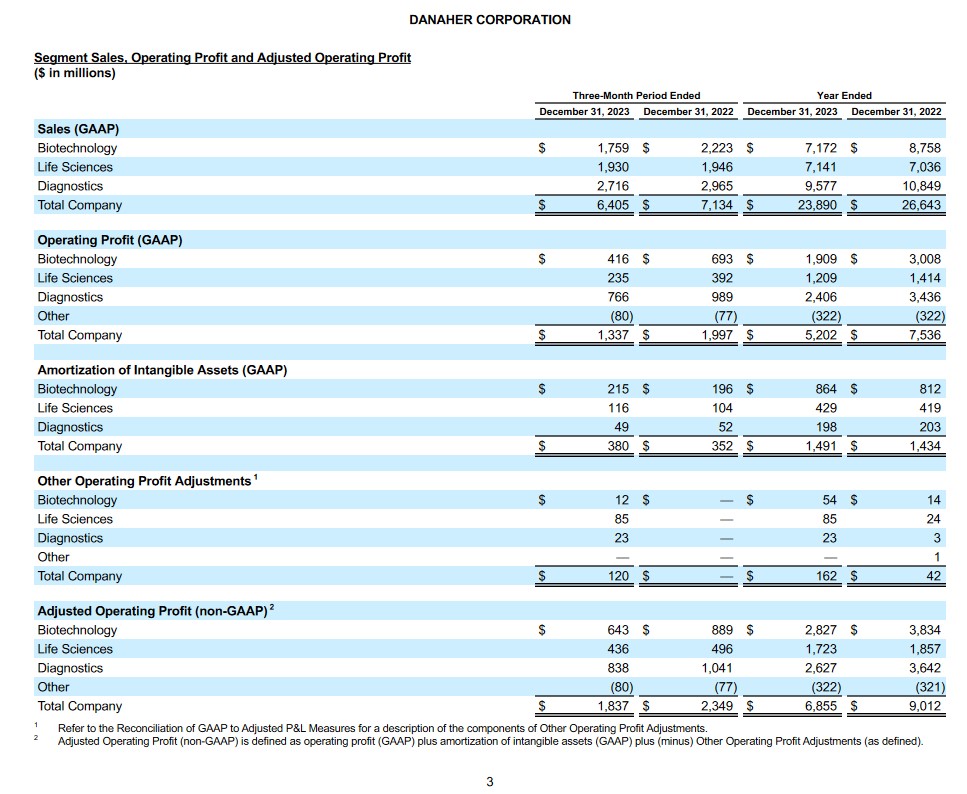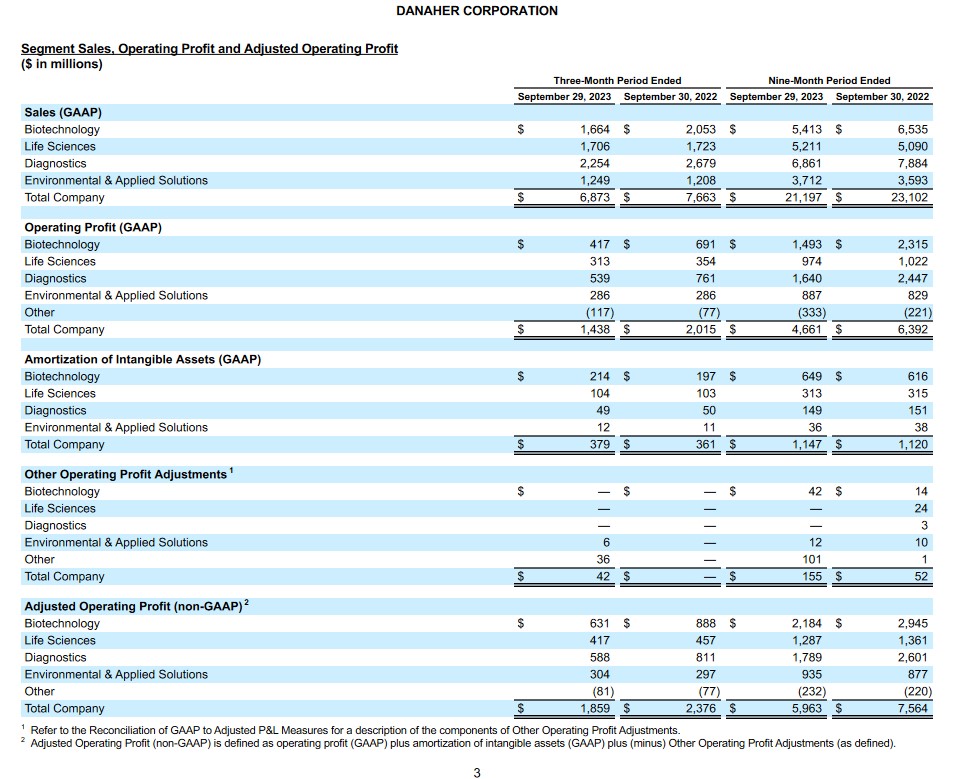Contents

My most recent prior Danaher (DHR) posts are entitled Danaher Consistently Generates Strong Free Cash Flow and Danaher - Current Weakness Is A Buying Opportunity. They were written following the release of Q2 and Q3 results, respectively.
As noted in my October 25, 2023 post, DHR embarked on a journey to strategically enhance its portfolio and strengthen growth and earnings trajectories.
On September 30, 2023, it spun-off Veralto (VLTO) thus becoming a focused life sciences and diagnostics innovator. Establishing Veralto as a stand-alone public company was the first step in the portfolio transformation process. The acquisition of Abcam, which closed in December, further increases DHR's focus on the highly attractive life sciences and diagnostics markets.
FY2023 was a challenging year operationally as pandemic tailwinds became headwinds. In addition, the outlook for FY2024 calls for a sales decline. Over the long-term, however, management expects DHR to be a faster-growing business with higher margins and stronger free cash flow generation.
Now that DHR has released its Q4 and FY2023 results and its FY2024 outlook, I revisit this existing holding.
Overview
I encourage the review the first section within DHR's Form 10-K for a good explanation of the company's business and risks. The FY2022 Form 10-K, however, is somewhat outdated because of the divestiture of VLTO. I, therefore, also suggest reading the 'Overview' section within the Q3 2023 Form 10-Q that commences on page 28 of 86.
In addition, Notes 2 and 3 (page 8 of 86) in the Q3 2023 Form 10-Q address:
- the spin-off of the Evironmental & Applied Solutions business (VLTO); and
- the terms of DHR's acquisition of Abcam plc for a cash purchase price of ~$5.7B, including assumed indebtedness and net of acquired cash.
Financials
Q4 and FY2023 Results
With the divestiture of the VLTO, DHR's Q4 and FY2023 results differ from what was presented with the release of Q3 results.
Furthermore, the Abcam acquisition was to close in the 2nd half of FY2024. DHR, however, closed this acquisition on December 6, 2023. As a result, DHR's FYE2023 results are distorted because:
- it disbursed $5.61B just before fiscal year end; and
- only briefly owned Abcam in FY2023.
The Q4 and FY2023 results are accessible here. For ease of comparison, however, I provide the following.
VLTO was part of DHR through the end of Q3. The financial highlights reflected below, therefore, include results for 4 business segments.
Operating Cash Flow (OCF) and Free Cash Flow (FCF)
DHR views FCF generation as one of the most important metrics. Investors, much like DHR's management, should pay particularly close attention to DHR's OCF and FCF.
Since DHR actively acquires and divests assets, its diluted EPS is deceiving. 'Amortization of intangible assets' and 'amortization of acquisition-related inventory fair value step-up' are line items that consistently appear in the Consolidated Condensed Statements of Cash Flows.
A comparison of DHR YoY is difficult because of its acquisition/divestiture activity. Nevertheless, its FCF/Net Income (FCF conversion ratio) is typically in excess of 100%. FY2023 was no exception. FCF from continuing operations to net earnings from continuing operations was 121%.
This marks the 32nd consecutive year DHR's FCF to net income conversion ratio exceeds 100%.

Source: DHR - Q4 and FY2023 Earnings Supplement - January 30, 2024
FY2024 Guidance
DHR's Q4 and FY2024 guidance include only DHR's continuing operations and exclude VLTO.

Source: DHR - Q4 and FY2023 Earnings Supplement - January 30, 2024
Expectations are for business conditions in DHR's bioprocessing segment to remain challenging and in particular....the Chinese market.
On the Q4 earnings call, management stated that the outlook is for a low-single-digit decline in core revenue with a weaker first half of the year than the second half.
The current forecast calls for declines in the biotechnology and life science end markets with mild growth in the diagnostic business segment.
DHR's focus on continuous improvement could lead to operating margin expansion in 2024. However, higher non-operating items such as the expected tax rate and an increase in the weighted average number of diluted shares outstanding may pressure FY2024 EPS.
Credit Ratings
The FYE2023 schedule of DHR's long-term debt is currently unavailable because the Form 10-K has yet to be released.
Looking at the Q3 2023 schedule of long term debt, we see that DHR has borrowed at very attractive rates. In addition, the scheduled maturity dates are well staggered.

Source: DHR - Q3 2023 Form 10-Q
At FYE2023, DHR had $16.707B of outstanding long-term debt versus $22.06B at the end of Q3 2023. It also had $1.695B of notes payable and current portion of long-term debt versus $2.547B at the end of Q3 2023.
In my prior post, I provided the following commentary regarding the VLTO debt.
We see from DHR's debt schedule at the end of Q3 2023 that debt has been raised at very attractive rates. Furthermore, maturity dates are well-balanced and go far out on the calendar.
DHR initially guaranteed the VLTO debt. The guarantee automatically terminated effective as of September 30 when DHR received net cash distributions of ~$2.6B from VLTO as partial
consideration for DHR's contribution of assets to VLTO in connection with the Separation Date. As of September 29, 2023, VLTO was a wholly-owned, consolidated subsidiary of DHR. DHR's Consolidated Balance Sheet as of September 29, 2023, therefore, includes the VLTO debt.The transfer of the liabilities associated with the VLTO debt, as well as all other assets and liabilities transferred to VLTO, will be reflected in DHR's Q4 2023 financial statements.
In accordance with applicable tax rules, DHR intends to use a portion of ~$2.6B to meet upcoming commercial paper and bond maturities and to use the balance of the proceeds to partially fund certain of the regular, quarterly cash dividends to shareholders.
I also gauge a company's credit risk by looking at the credit ratings assigned by the rating agencies.
DHR's credit ratings are unchanged from my last review.
- Moody's: Upgraded to A3 from Baa1 on October 10, 2022;
- S&P Global: Upgraded to A- from BBB+ on June 14, 2022.
Both ratings are at the bottom tier of the upper-medium investment-grade tier. This rating defines DHR as having a STRONG capacity to meet its financial commitments. However, DHR is somewhat more susceptible to the adverse effects of changes in circumstances and economic conditions than obligors in higher-rated categories.
These ratings satisfy my conservative investment profile.
Dividend and Dividend Yield
DHR distributes a quarterly dividend. This component of DHR's total potential investment return, however, is relatively insignificant. The reason for this is that DHR is hyper-focused on capital allocation and the Board feels superior long-term investor returns can be generated by retaining funds in the company.
DHR distributed its 3rd consecutive $0.27/share quarterly dividend on October 27, 2023. When it declared its quarterly dividend in December, it lowered the quarterly dividend to $0.24. This decision was made taking into consideration shareholders being rewarded from the Veralto spin-off.
With shares trading at ~$240 as I compose this post, the dividend yield is negligible. Investors who rely on dividend income might immediately pass on DHR because of this low dividend yield. However, investors should not fixate on dividend metrics. The focus should be on total potential long-term investment returns.
On July 16, 2013, DHR's Board approved a repurchase program authorizing the repurchase of up to 20 million shares from time to time on the open market or in privately negotiated transactions. As of December 31, 2023, ~20 million shares remain available for repurchase under the Repurchase Program.
The diluted average common stock and common equivalent shares outstanding (in millions) in FY2012 - FY2023 are 713, 711, 716, 709, 700, 706, 710, 726, 719, 737, and 737. This rose to ~746.1 for the last quarter of FY2023 which was almost equivalent to the number of diluted shares outstanding for the 3 months ending September 29, 2023 (~745.9).
The increase in diluted average common stock and common equivalent shares outstanding in recent years is primarily the result of the conversion of On April 15, 2022, all outstanding shares of the 4.75% MCPS Series A converted and on April 15, 2023, the 5% MCPS Series B converted.
Valuation
As noted in my October 25, 2023 post, trying to compare DHR's current valuation relative to its historical valuation is difficult. This is because it has undergone a radical transformation over the last few years after having divested slower-growing businesses and acquiring several faster-growing businesses.
If we compare historical PE levels against current levels we can reach misleading conclusions.
Since the active acquisition/divestiture of businesses distorts EPS, I also look at DHR's Price/FCF to gauge its valuation.
When I last reviewed DHR, it had reported a YTD2023 FCF to net income conversion of 124% in the first 9 months of FY2023. I elected, however, to stick with my arbitrary 120% FCF to net income conversion ratio to gauge DHR's valuation. I then:
- multiplied the the FY2023 $8.57 mean adjusted diluted EPS guidance from analysts by 120%, thereby giving me $10.28 FCF/share; and
- divided the ~$197 share price by $10.28 thus giving me a ~19.2 P/FCF.
At the same time, I took the ~$197 share price and the forward-adjusted diluted EPS broker estimates to calculate DHR's forward-adjusted diluted PE.
- FY2023 - 29 brokers - mean of $8.57 and low/high of $8.21 - $9.01. Using the mean estimate, the forward adjusted diluted PE was ~23.
- FY2024 - 14 brokers - mean of $8.05 and low/high of $7.27 - $9.80. Using the mean estimate, the forward adjusted diluted PE was ~24.5.
- FY2025 - 11 brokers - mean of $8.95 and low/high of $8.14 - $10.19. Using the mean estimate, the forward adjusted diluted PE was ~22.
We now know that DHR generated $5.65 of diluted EPS and $7.58 of adjusted diluted EPS in FY2023. With shares trading at ~$240, the diluted PE is ~42 and the adjusted diluted PE is ~32. This is well above the level at the time of my October 25 post.
DHR's forward adjusted diluted PE levels using the the forward-adjusted diluted EPS broker estimates and the current ~$240 share price are:
- FY2024 - 25 brokers - mean of $7.68 and low/high of $7.20 - $8.46. Using the mean estimate, the forward adjusted diluted PE is ~31.
- FY2025 - 24 brokers - mean of $8.72 and low/high of $8.15 - $9.70. Using the mean estimate, the forward adjusted diluted PE is ~28.
- FY2026 - 14 brokers - mean of $9.68 and low/high of $9.00 - $10.45. Using the mean estimate, the forward adjusted diluted PE is ~25.
Multiplying the FY2024 $7.68 mean adjusted diluted EPS guidance from analysts by 120%, we get $9.22 FCF/share. Divide ~$240 by $9.22 and we get a ~26 P/FCF.
DHR is not as attractively valued as at the time of my prior post.
Final Thoughts
Despite challenges throughout 2023, DHR continues to strengthen its portfolio with M&A and through proactive steps to improve its cost structure. It has exited the pandemic as a stronger company having replaced revenue contribution from spun-off entities (Envista in 2019 and Veralto in 2023) with higher growth, higher-margin annuities with the Cytiva, Aldevron and Abcam acquisitions. In addition, Cepheid's respiratory franchise is now 6x larger than it was prior to the pandemic; the acquisition of Cepheid closed at the beginning of November 2016.
I currently hold 445 shares in a 'Core' account in the FFJ Portfolio; DHR was my 28th largest holding when I completed my 2023 Year End FFJ Portfolio Review.
While my monthly FFJ Portfolio reports reflects a small unrealized loss, I sold the 148 VLTO shares received from the spin-off at an average cost of ~$77.22. My DHR position, therefore, is essentially flat.
In hindsight, I should have scrounged up enough money to acquire at least another 100 shares at ~$188 in late October 2023 at which time DHR's valuation was very attractive. Unfortunately, October/November is typically the time of the year where I have other financial commitments.
As noted in several previous posts, I am trying (struggling!) to identify great companies whose valuation has come under pressure because of short-term headwinds. DHR is experiencing headwinds that will eventually fade and I anticipate annual growth will rebound and eventually normalize in the high single digits for revenue and low double digits for earnings. HOWEVER, DHR's share price has been on a tear since late October 2023 and shares are now fairly valued.
I remain cautious in this environment and sitting on the sidelines hoping for a nice broad market pullback. Should one occur, I hope DHR's valuation will approach the FY2024 level it attained when I completed my October 25, 2023 post.
I wish you much success on your journey to financial freedom!
Note: Please send any feedback, corrections, or questions to [email protected].
Disclosure: I am long DHR.
Disclaimer: I do not know your circumstances and do not provide individualized advice or recommendations. I encourage you to make investment decisions by conducting your research and due diligence. Consult your financial advisor about your specific situation.
I wrote this article myself and it expresses my own opinions. I do not receive compensation for it and have no business relationship with any company mentioned in this article.



